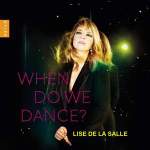|
Back
06/19/2021
“When Do We Dance?”
George Gershwin: When Do We Dance?
Art Tatum: Tea for Two
William Bolcom: Graceful Ghost Rag
Fats Waller: Vipers Drag
Astor Piazzolla: Libertango
Alberto Evaristo Gianestra: Danzas Argentinas, opus 2
Manuel de Falla: El Amor Brujo: “Ritual Fire Dance”
Maurice Ravel: Valses nobles et sentimentales
Camille Saint-Saëns: Six Etudes, opus 52: n° 6. “Etude en forme de valse”
Béla Bartók: Romanian Folk Dances, sz. 56, BB 68
Igor Stravinsky: Tango
Alexander Scriabin: Waltz in A-Flat major, opus 38
Sergei Rachmaninoff (trans. V. Gryaznov): Polka Italienne
Lise de la Salle (piano)
Recording: Teldex Studio, Berlin, Germany (August 29-31, 2020) – 81’29
Naïve Classiques V 5468 (Distributed by Naxos of America) – Booklet in French, English and German

   
French pianist Lise de la Salle trips the light fantastic with her recording “When Do We Dance?” which is the title track Gershwin tune that kicks off a vibrant musical tour of international dance music.
From jazz age allure of classic jazz to Astor Piazzolla’s smoldering tango or Bartók’s mystical European fusion and Ravel’s transporting tone poems, this collection enchants. In the CD booklet, de la Salle speaks of her love for dance music, and in this recording she wanted to perform compositions from 1850 to 1950 which, in her view, is the genre’s most fertile and musically diverse era.
Her technical range and understanding of the specific dance musicality in these solo piano transcriptions are impressive: from the light touch and signature jazz arpeggios of Art Tatum’s version of Tea for Two to the folkloric mystique of Béla Bartók’s Romanian Folk Dances.
De la Salle locks in all the rhythmic drama and sensual counterpoints in her smoldering piano transcription of Piazzolla’s Libertango. Piazzolla is a perfect prelude to Alberto Ginastera’s three-movement Danzas Argentinas, instantly intoxicating in its cultural lyricism and de la Salle’s expressive technical artistry. Ginastera’s final movement is a frenzied rondo with its jazz scramble opening bars, then giving way to a thrilling paced rondo. De la Salle delivers her most soulful performance in this collection. Then onto Spain for Manuel de Falla’s Danza Ritual del Fuego (Ritual Fire Dance), a timeless neoclassical Spanish masterpiece.
The dance journey continues across the border in France with de la Salle’s vivid interpretation of Ravel’s Valses nobles et sentimentales, the first being “Modéré, très franc”, which sweeps us into the Paris clouds with a waltz. The eight scènes d’action de danse of Ravellian tone poem watercolors in lost romance and ethereal musings are as vivid as ever in de la Salle’s hands. Then Camille Saint-Saëns’ haltingly elegant Etude en forme de valse swirls into a dizzyingly wry dance.
Meanwhile, from Russia with dance love is Alexander Scriabin’s Waltz in A-Flat major where de la Salle’s steely delicacy in the classical style completely charms. And it almost strikes as ironic how conventional Igor Stravinsky is with his composition, Tango, with its sharp counterpoints and romanticism; meanwhile, de la Salle delivers all of Igor’s lusty swagger at the keyboard.
From Hungary is Béla Bartók’s Romanian Folk Dances, six miniatures that are spellbinding as they conjure specific dances. The most familiar is the “Topogo” (“In One Spot”) that simply radiates with folkloric mystique.
And back in Chicago circa 1935, the late great stride pianist Fats Waller would raise an eyebrow in approval if he were here to listen to Lise de la Salle shamelessly vamping his tune Viper’s Rag for all it’s worth.
Lewis J. Whittington
|